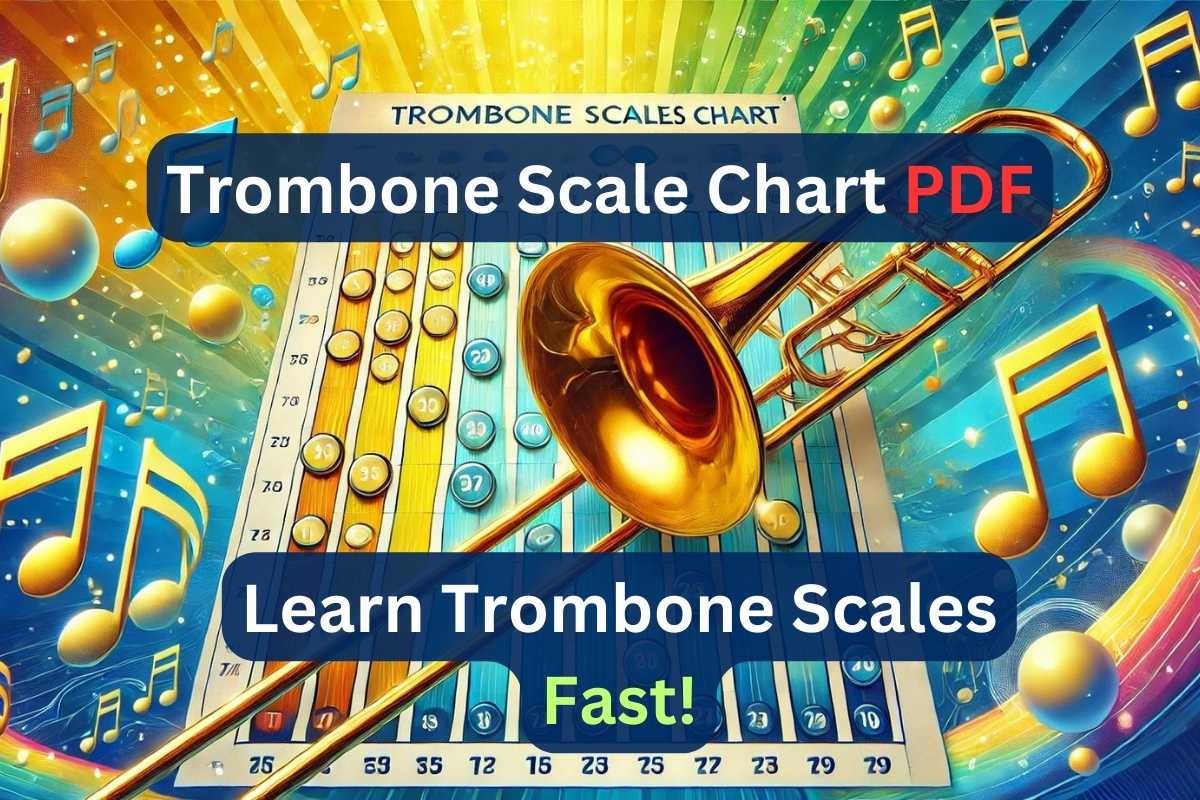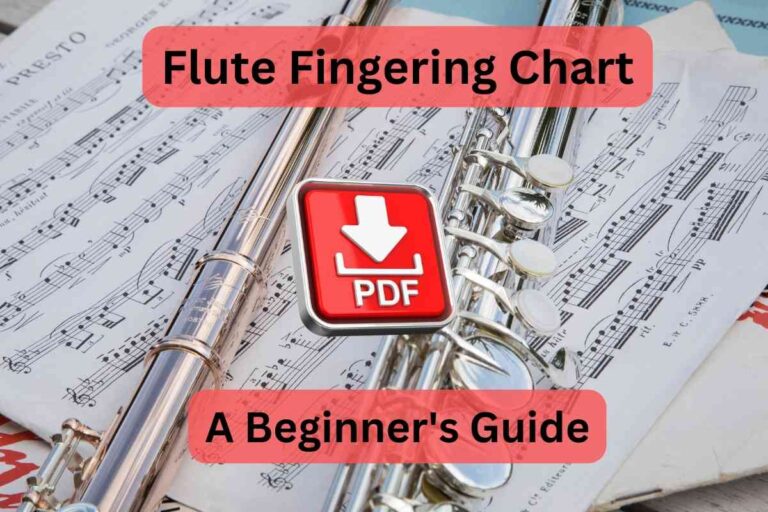Trombone Scale Chart PDF — Learn Trombone Scales Fast in 2025

Have you ever wondered what a trombone scale chart is and why it is important for your playing?
We will explore the different types of trombone scales, how to read a trombone scale chart, and the basic techniques for playing them.
Get tips for practicing trombone scales, avoid common mistakes, and download free trombone scale charts to improve your skills. So, grab your trombone and get ready to master those scales!
Key Takeaways:
Trombone scales are a vital part of playing the trombone and understanding them is necessary for improvement.
Proper breathing technique, consistency, and seeking feedback are crucial for mastering trombone scales.
Free downloadable PDF trombone scale charts are easily available online and can be used for practicing in different keys and improving playing skills.
What Are Trombone Scales?
Trombone scales are sequences of musical notes ordered by pitch, crucial for mastering the trombone and understanding the fundamentals of music theory.


By practicing trombone scales, players internalize the harmonic structure of music, enabling them to navigate various genres and styles with ease. Trombone scales are the foundation upon which complex melodies are built, enhancing a player’s ability to improvise and compose. Mastering scales helps trombonists develop muscle memory and finger dexterity, leading to improved intonation and fluidity in their performances. Understanding scales also aids in ensemble playing, as it allows musicians to effortlessly blend their sound with other instruments.
Why Are Trombone Scales Important?
Trombone scales are important because they help players improve their intonation, familiarize themselves with the harmonic series, and develop a disciplined practice routine.
Practicing trombone scales can enhance a musician’s ability to play in tune with different ensembles, refine their ear for pitch recognition, and deepen their understanding of key signatures and intervals.
By consistently working through scales, trombonists can also strengthen their embouchure, increase breath control, and achieve greater dexterity in navigating the instrument’s range. This systematic approach aids in building muscle memory and agility, leading to smoother transitions between notes and facilitating complex musical passages.
How to Read a Trombone Scale Chart?
Reading a trombone scale chart involves understanding the notation of notes and their corresponding slide positions, enabling trombone players to accurately perform various scales.
What Are the Different Types of Trombone Scales?
The different types of trombone scales include major scales, minor scales, and chromatic scales, each serving distinct musical purposes.
Major scales are known for their happy and uplifting sound, often used to create a sense of resolution and stability in music. For example, a C major scale consists of the notes C, D, E, F, G, A, B, and C, played in ascending order.
On the other hand, minor scales evoke a more melancholic and somber mood, adding depth and richness to musical compositions. An A minor scale features the notes A, B, C, D, E, F, G, and A.
Chromatic scales consist of all twelve notes within an octave, offering a sense of tension and dissonance. They are commonly used for dramatic effect or to transition between different keys smoothly.
[Read my other post with “Trombone Chromatic Scale — 12 Easy But Must Tips”]
What Are the Basic Techniques for Playing Trombone Scales?
The basic techniques for playing trombone scales include maintaining a proper embouchure, precise slide movement, and consistent airflow.
Developing a stable embouchure is crucial for producing a clear and centered sound. Ensuring that the corners of the mouth remain firm yet flexible allows for better control over the airflow.
Mastering accurate slide positions is essential for hitting the right notes without compromising intonation. Regularly practicing scales helps in memorizing the exact slide placements required for each pitch.
Controlled breathing plays a significant role in sustaining long phrases and maintaining a consistent tone quality throughout the scale. Proper breathing techniques, such as diaphragmatic breathing, support a steady airflow and improve endurance during extended playing sessions.
Tips for Practicing Trombone Scales
Practicing trombone scales effectively involves a combination of methodical approaches and practical tips that help players enhance their technique and musicality.
Start Slow and Gradually Increase Speed
Starting slow and gradually increasing speed is essential when practicing trombone scales to ensure accuracy and control in slide positions and notes.
By taking a measured approach, players can develop muscle memory and build a strong foundation for more complex pieces.
Consistency in practicing at a slower pace allows for a deeper understanding of the music and helps in mastering the nuances of each scale.
- Improving technique gradually also reduces the risk of injury during intense playing sessions.
Remember, it’s about quality over quantity – each slow, deliberate repetition is a step towards achieving mastery.”
[Read my “Guide To Kickstart Trombone For Beginners”]
Use a Metronome
Using a metronome while practicing trombone scales helps players maintain consistent timing and develop a strong sense of rhythm.
One of the key advantages of incorporating a metronome into your practice routine is its ability to aid in building a steady tempo. By playing along with the metronome, you train yourself to stay in sync with a consistent beat, which is essential for ensemble playing and musical performances.
Regular metronome practice can greatly improve rhythmic accuracy. With the metronome acting as a constant guide, players learn to internalize and execute complex rhythms with precision, leading to more polished musical performances.
Focus on Proper Technique
Focusing on proper technique involves ensuring correct embouchure, precise slide positions, and controlled breathing while playing trombone scales.
A stable embouchure is essential for producing clear and consistent tones on the trombone. It is important to maintain a relaxed but firm mouth position, with the corners of the mouth slightly tucked in.
To achieve accurate slide movements, players should practice smooth and quick transitions between positions, ensuring a seamless connection between notes. Efficient breathing habits play a crucial role in sustaining long phrases and executing dynamic changes. Remember to take deep breaths from the diaphragm, allowing for a steady flow of air while playing.
Practice in Different Keys
Practicing trombone scales in different keys enhances a player’s versatility and prepares them for various musical situations.
By mastering scales in various keys, a trombone player can develop a strong foundation in music theory and technical skills. This ability allows the player to adapt to different genres and styles of music effortlessly.
[Still learning Trombone? Chick my “Trombone Slide Chart For Starters”]
To systematically practice scales in different keys, it is essential to start with familiar keys and gradually progress to more challenging ones. Utilizing a practice routine that covers all keys regularly helps in reinforcing muscle memory and promoting a deep understanding of each key’s unique characteristics.
Common Mistakes When Playing Trombone Scales
Common mistakes when playing trombone scales include improper breathing technique, rushing through scales, and neglecting dynamics, all of which can hinder musical development.
Not Using Proper Breathing Technique
Not using proper breathing technique can lead to inconsistent airflow and negatively affect the sound quality when playing trombone scales.
Developing good breathing habits is essential for musicians, especially trombonists, to produce a rich and resonant tone.
One tip to improve airflow during scale practice is to focus on deep diaphragmatic breathing, rather than shallow chest breathing. This ensures that your lungs are fully filled with air, providing the necessary support for sustained notes.
Incorporating breathing exercises into your daily routine, such as breathing in for counts of 4 and out for counts of 8, can help strengthen your respiratory muscles.
Rushing Through Scales
Rushing through scales often results in poor accuracy and control, making it crucial for trombone players to maintain a steady tempo.
One effective strategy to improve accuracy and control is to start scales at a slower tempo and gradually increase speed as confidence grows. This gradual approach allows for better muscle memory development and ensures precision. Focusing on proper breathing techniques and embouchure formation while practicing scales can greatly enhance overall performance.
Another helpful tip is to break down scales into smaller sections and master each part before attempting to play the entire scale. By practicing with patience and attention to detail, trombone players can achieve greater fluency and mastery in their scales.
Not Paying Attention to Dynamics
Not paying attention to dynamics can make scale practice monotonous and hinder a player’s musical expression on the trombone.
When practicing scales on the trombone, it’s crucial to remember that dynamics play a vital role in enhancing your overall musicality. By incorporating dynamic variations, you can bring life and depth to your playing, making your practice sessions more engaging and expressive.
One effective way to incorporate expressive elements into your scale practice is by consciously varying the volume and intensity of your playing. Start by practicing scales softly, gradually increasing the volume to fortissimo and then bringing it back down again. This dynamic contrast will not only improve your technical control but also add a sense of drama and emotion to your music.
Where to Find Free Trombone Scale Charts?
Free trombone scale charts can be found on various online platforms (including this one, ofc), offering accessible resources for trombone players of all levels.
One popular website for free trombone scale charts is 8notes.com, where users can find a wide range of scales in various keys. Additionally, musictheory.net provides interactive tools and lessons to help players master trombone scales effectively.
For those looking for printable charts, Yamaha offers a collection of downloadable charts curated by experienced musicians. It’s important to verify the accuracy of the scales by cross-referencing with reputable music education sites or apps like SmartMusic.
How to Use a Trombone Scale Chart for Improving Playing Skills?
Using a trombone scale chart effectively improves your skills by providing structured practice guidelines and visual aids for note positions.
One key strategy for incorporating scale charts into daily practice routines is to FIRST familiarize oneself with the layout and structure of the chart.
This identifies the key signatures, intervals, and fingerings displayed on the chart to better understand how to navigate different scales and keys.
By utilizing the scale chart REGULARY, players can gradually enhance their muscle memory and finger dexterity, leading to smoother transitions between notes and improved technique.
Tips for Mastering Trombone Scales
Mastering trombone scales requires a combination of consistent practice, attention to detail, and utilizing various tips and techniques to refine playing skills.
Practice Consistently
Consistent practice is key to mastering trombone scales, as it helps build muscle memory and reinforces learning.
One effective tip is to set aside a specific time each day dedicated solely to practicing scales. This regular routine helps create a habit and ensures that practice does not get overlooked in the busyness of daily life.
Breaking down practice sessions into smaller, manageable chunks can make the process less daunting. Focus on one scale at a time, gradually increasing the complexity as mastery is achieved.
Incorporating different practice techniques such as slow play, rhythmic variations, and metronome use can enhance skill development and prevent monotony.”
Listen to Professional Recordings
Listening to professional recordings can provide valuable insights into tone quality, technique, and musical interpretation for trombone players.
When players immerse themselves in the sounds of seasoned professionals, they can pick up on subtleties that elevate their own playing to a new level.
This exposure not only sharpens their ears but also helps in developing a deeper understanding of phrasing and dynamics.
By studying the nuances of these expert performances, players can incorporate innovative approaches and refine their skills in playing various scales.
Listening to different styles and genres can broaden players’ musical horizon, sparking creativity and versatility in their trombone repertoire.
Seek Feedback from a Teacher or Mentor
Seeking feedback from a teacher or mentor can provide personalized guidance and help identify areas for improvement in trombone scale practice.
Receiving expert feedback not only assists in refining technical skills but also offers valuable insights into musical interpretation and performance. When communicating with mentors, it is essential to maintain an open mind and willingness to receive constructive criticism. Actively listening to their suggestions and implementing them during practice sessions can lead to noticeable progress and growth as a musician. By incorporating the feedback given by experienced individuals, trombonists can fine-tune their playing technique, address weaknesses, and ultimately enhance their overall musicianship. This interactive process fosters a supportive learning environment where mentorship plays a pivotal role in honing one’s musical craft.https://www.youtube.com/embed/rc1EPud2VAQ
Frequently Asked Questions
Q. What is a trombone scale chart?
A. A trombone scale chart is a visual representation of the different scales that can be played on a trombone. It shows the notes and finger positions required to play each scale in a clear and organized manner.
Q. How can I use a trombone scale chart to improve my playing?
A. A trombone scale chart can be a helpful tool for improving your playing by providing a clear and concise reference for the various scales. By practicing these scales regularly, you can improve your muscle memory and overall technique on the instrument.
Q. Are there different types of trombone scale charts?
A. Yes, there are various types of trombone scale charts available. Some charts may focus on specific scales or techniques, while others may provide a comprehensive overview of all scales. It is important to find a chart that suits your specific needs and goals.
Q. Can I download a trombone scale chart?
A. Yes, many websites offer downloadable PDF documents of trombone scale charts that you can print and use for your practice sessions. These charts are often free and can be easily accessed from any device.
A. Do I need to be able to read sheet music to use a trombone scale chart?
A. While having knowledge of sheet music can be helpful, it is not necessary to be able to read sheet music to use a trombone scale chart. The finger positions and note names are typically included on the chart, making it accessible for players of all levels.
Q. Can a trombone scale chart be used for other brass instruments?
A. Yes, many scales are universal among different brass instruments, so a trombone scale chart can be used as a reference for other instruments (such as the trumpet or tuba). However, each instrument may have slight variations in fingerings and techniques.






